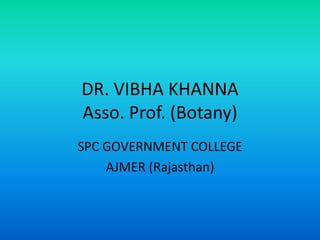
Lipids: Structure and Functions
- 1. DR. VIBHA KHANNA Asso. Prof. (Botany) SPC GOVERNMENT COLLEGE AJMER (Rajasthan)
- 2. PLANT BIOCHEMISTRY • BLOCK 1. : Lipid metabolism – PRESENTATION 1: Structure and function of lipids,
- 3. LIPIDS • Term first used by German biochemist Bloor in 1943. • The word lipid is derived from a Greek word “lipos” which means Fat. • They are: 1. Insoluble in water. 2. Soluble in non-polar organic solvents e.g. ether, acetone. 3. Contain carbon, hydrogen and oxygen sometimes contain nitrogen and phosphorous. 4. Neutral lipids upon hydrolysis yield glycerol and fatty acids*. 5. Take part in plant and animal metabolism. 6. In aqueous environment lipid molecules associate by non – covalent interactions to form supramolecular structures such as monolayers,micelles,bilayers,and vesicles.
- 4. • FATTY ACIDS* • Fatty acids are a class of compounds containing a long hydrophobic hydrocarbon chain and a terminal carboxylate group. • Fatty acid are long chain organic acids usually from 4 to 30 carbon atoms. • Fatty acid which occur in natural fats are usually monocarboxylic and contain even number of carbon atoms as these synthesized from two carbon units. • The chain may be saturated or unsaturated. • Some fatty acid have hydroxyl group in the chain and still other may possess ring structure
- 5. CLASSIFICATION OF LIPIDS: On the basis of Structure
- 6. CLASSIFICATION OF LIPIDS : On the basis of Functions LIPIDS STORAGE LIPIDS MEMBRANE LIPIDS CELL SIGNALLING
- 7. MEMBRANE LIPIDS: • All living cells are enclosed in membrane. • These membrane define the inner and outer boundary of the cells and also the compartmentalisation of different organelles within the cell. • The biological membrane consists of a double layer of lipids and the proteins. • Lipid are hydrophobic in nature they provide effective barrier to polar molecules. • Variety of lipid are known to be present in biological membrane.
- 9. PHOSPHOLIPID: • Phospholipid are the most abundant membrane lipid. • They serve primarily as structural components of membrane and are never stored in large quantities. • Phospholipids consist of a glycerol molecule, two fatty acids, and a phosphate group that is modified by an alcohol. • They are amphipathic. – The phosphate group is the negatively-charged polar head, which is hydrophilic. – The fatty acid chains are the uncharged, nonpolar tails, which are hydrophobic. • Phospholipid are compound lipid and are of three types; 1. Phosphoglycereids 2. Phosphoinositides 3. Phosphosphingosides.
- 10. PHOSPHOLIPID: Phosphoglycereids • Phosphoglycerides have three parts: – a three-carbon backbone of glycerol, – two long-chain fatty acids esterified (or attached via an ether link in Archaea) to hydroxyl groups on carbons 1 and 2 (C1 and C2) of the glycerol and – a highly polar or charged group ( like phosphoric acid) esterified to the C3 hydroxyl group of glycerol. • Lecithin is a phospholipid which consists of glycerol, two fatty acids, a phosphate group and choline. (Lecithins are widely distributed in nature, including various oil seeds like soybean and the yeasts .) • Cephalins contain the amino alcohols serine or ethanolamine(in place of choline). (Cephalins are found in most cell membranes, in animal world. They have been identified from soybean oil.)
- 11. PHOSPHOLIPID: Phosphoinositides • Phosphatidylinositol is an acidic (anionic) phospholipid that basically, consists of a phosphatidic acid backbone, linked via the phosphate group to inositol (hexahydroxycyclohexane). • Phosphoinositides are the phosphorylated derivatives of phosphatidylinositol. • They have three parts: – a three-carbon backbone of glycerol, – two long-chain fatty acids esterified to hydroxyl groups on carbons 1 and 2 (C1 and C2) of the glycerol and – attached to a polar head group (the cyclic hexahydroxy alcohol called inositol) that extends into the cytoplasm. [The inositol is present as the stereoisomer, myo-inositol.] • Examples: phosphatidylinositol 3,4,5-trisphosphate, often called PIP3 ; phosphatidylinositol 4,5-bisphosphate, often called PIP2 • *Phosphosphingosides: apparently lack in plants and the microorganisms.
- 12. GLYCOLIPID • Glycolipid is a structural lipid. They are made up of lipids and carbohydrate. • It consists of a hydrophobic lipid tail and one or more hydrophilic sugar groups linked by a glycosidic bond. • Glycolipids are components of cellular membranes • They are generally found on the extracellular face of eukaryotic cellular membrane. • They are also present on the cell surface of some viruses, bacteria.
- 13. GLYCOLIPIDS • The basic structure of a glycolipid consists of a mono- or oligosaccharide group attached to a sphingolipid or a glycerol group, which can be acetylated or alkylated, with one or two fatty acids. • These make up the two classes – Glycosphingolipids and – Glycoglycerolipids • Glycolipids interact and bind to the lipid-bilayer through the hydrophobic nature of the lipid tail which anchors it to the surface of the plasma membrane.
- 14. Cholesterol • Cholesterol is a steroid derivative and is present as membrane lipid in almost all animal membranes. • Derivatives of steroids, however, are also found in plants, fungi, and some bacteria. • Cholesterol is a lipid with a unique structure consisting of four linked hydrocarbon rings forming the bulky steroid structure. There is a hydrocarbon tail linked to one end of the steroid and a hydroxyl group linked to the other end. • The steroid nucleus consist of four rings numbered A,B,C,D. the first three rings have 6 carbons whereas the fourth has only 5 carbons.
- 15. REFERENCES: Biochemistry And Molecular Biology Of Plants : Buchanan, Gruissem, Jones Plant Physiology : Mohr